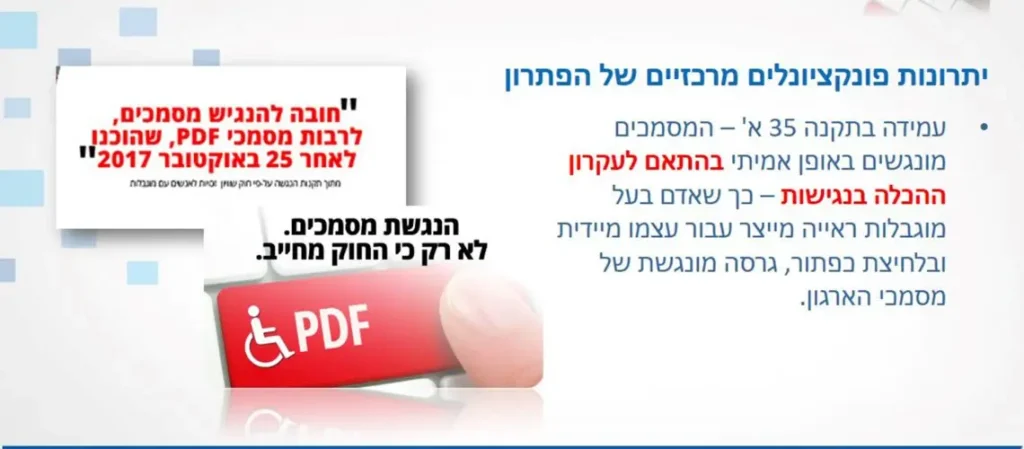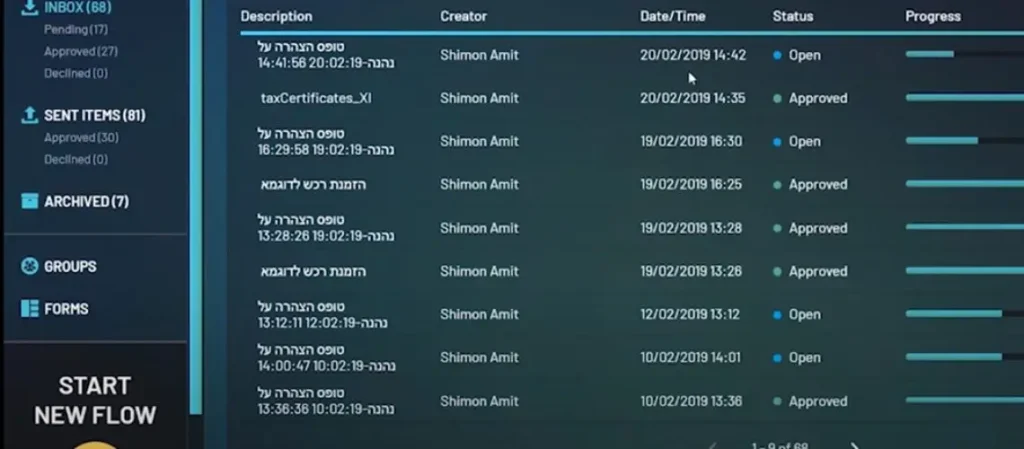Regulation 35A of the Equal Rights for Persons with Disabilities Law, which requires organizations and businesses to make accessible every document prepared from October 26, 2017 onward, came fully into effect at the beginning of the current year, 2022. Therefore, from January 1 onward, organizations are required to immediately provide accessible documents to customers – financial reports, public protocols, customer forms, etc. – in accordance with the principle of inclusion in accessibility.
During 2021, in preparation for the regulation coming into effect, at Consist we made accessible, through a special technological solution we developed, millions of documents of most of the major banks and other leading organizations. The system that enabled us at Consist to make such a significant number of documents accessible is called NAGIX – and we wanted to share with you the process that today allows organizations to provide their customers with an accessible version of any document, at the click of a button – in accordance with the principle of inclusion in accessibility.
Let’s start from the beginning: What is an accessible document, and what is the principle of inclusion in accessibility?
Accessible document is one that a person with visual impairment can listen to through screen reader software. The accessibility process creates a PDF document containing an accessibility tree that screen readers can read according to the order defined by the document’s accessibility implementer.
The principle of inclusion in accessibility states that making a document accessible alone does not meet the legal requirements, and accessibility must be such that it allows a person with a disability to operate in the public space like any other person. Accordingly, accessibility that upholds the principle of inclusion must allow a person with visual impairment to immediately create an accessible version of any customer document for themselves, without having to request the organization to make specific documents accessible individually.
This is similar to the principle of inclusion in physical accessibility of, for example, a public institution (or a café or restaurant, for that matter) where access is via stairs. Of course, such an institution cannot fulfill its obligation merely by placing a person at the bottom of the stairs to help people with mobility limitations climb. Accessibility according to the law and the principle of inclusion must enable mobility in the space like any other person, and therefore true accessibility requires, for example, installing an elevator or a ramp so that a person using a wheelchair can go up without relying on another person. The same principle applies to document accessibility, customer forms, public protocols, financial reports of public companies, and more.
Legal requirements regarding document accessibility
With the growing awareness over the years of the importance of accessibility in general and document accessibility in particular, at Consist we developed automatic document accessibility technology that operated within Consist’s digital forms system – PB Digital. During 2021, when it was clear that Regulation 35A would finally come into effect at the beginning of 2022 and there would be no further extension of leniency by the legislator, many organizations turned to Consist and asked us to formulate and implement for them a solution for making accessible the huge quantity of documents they had.
It is important to note that in large banks, for example, there are millions of documents requiring accessibility, and it is clear that with any technology other than automatic accessibility like that of NAGIX, an enormous and unrealistic number of work hours would be required to properly convert those millions of documents into accessible ones in accordance with the law and the principle of inclusion.
How do you approach accessibility of millions of existing documents? Using the repetitive accessibility method
To make accessible the huge quantity of documents existing in organizations, we defined all forms and documents requiring accessibility in each organization – invoices, customer documents, public protocols, financial reports, and more. At the same time, the documents and forms were divided into families, and for each family we created relevant tags including:
- Paragraphs
- Images
- Logos
- Amounts of money
- Dates
- Tables
- Graphs
- And more.
We assigned each form and document to one of the families, and then defined in the NAGIX system the elements from which each document is built.
Two stages of the automated repetitive accessibility solution
1. Design stage
In this stage the designer, using the unique NAGIX DESIGNER, defines the master templates for all types of forms and documents in the organization. In a bank or large financial institution, for example, the number of templates can reach hundreds or more. After all the organization’s documents were divided according to the structure of the various document types, the implementer, using NAGIX, creates a template for each type of document, composed of an accessibility tree.

In the example before us, the accessible PDF form (right) with the accessibility tree (left).

2. Production stage
After all documents in the organization were divided into families and master templates, each customer of the organization will automatically receive an accessible version of every document they need, even when it comes to millions of existing documents. NAGIX identifies the family and type of document the customer wishes to receive and is able to provide the screen reader with the template and order according to which the document should be read.

Special accessibility challenges that NAGIX addresses
Even the most advanced screen reader software cannot determine on its own, for example, whether a number in a document is an amount of money, a phone number, an address, etc. Likewise, tables and nested tables (a table within a table) present a special challenge in the world of document accessibility. To overcome these challenges, NAGIX integrates advanced technology that enables providing an optimal accessible customer experience. For example:
Phone numbers / phone numbers with an asterisk
Screen readers read the content of Hebrew documents from right to left. However, when it comes to a phone number, the digits must be read from left to right. Below is a real recording of an accessible document being read by NAGIX, where the system knows to read the digits of the bank’s phone number from left to right, and to switch to English when it comes to the website address.
Images, icons, and logos
Screen readers cannot read images, logos, icons, and symbols, but NAGIX allows the document implementer to provide a description of the image or logo, in a way that enables the screen reader to deliver a description of the visual.
Tables, nested tables, and rotated tables (landscape – as in the example below)
The NAGIX solution allows the accessibility implementer to define fields within tables, thereby providing clear accessibility even for complex content within tables, nested tables, and rotated tables. The system also knows how to define numbers, amounts of money, dates, and any other element within the tables, so that the screen reader knows to read the column heading as well as the column content in the order defined by the implementer. In this way, it is relatively easy for a person with visual impairment to follow the reading and understand the context of each piece of data in the table.
Graphs and data within a graph
Graphs based on information present a special challenge in document accessibility. However, NAGIX allows even such elements to be made accessible by linking the data file from which the information is derived. The PDF document displays the graph, while the data on which the graph is based is marked by the implementer in white. The NAGIX implementer knows how to associate each data point with the graph, so that the screen reader reads them in the accessible document.
Consist’s accessibility implementers task force
Because the amount of documents and forms we were required to make accessible was enormous, we quickly assembled a “task force of implementers” who succeeded in a very short time, using the NAGIX system, to make accessible for the company’s clients a huge variety of documents – protocols, customer letters and forms, financial reports, and more. Thanks to the accessibility implementers team we met the challenge, and today customers of these organizations generate for themselves accessible versions of any required document.
It is also important to add that our sense of satisfaction at Consist is enormous, not only because we accomplished the task we set for ourselves, but also, and mainly, because there is tremendous social value here – where a person with visual impairment can receive the information they require – without any limitation. Although the law requires it, at Consist we believe that the public space in general and documents in particular must be made accessible not only because the law mandates it, but because it is a top-tier social value, and we are happy and proud to take part in it.
Ofir Greiner and Shimon Amit. April 2022





